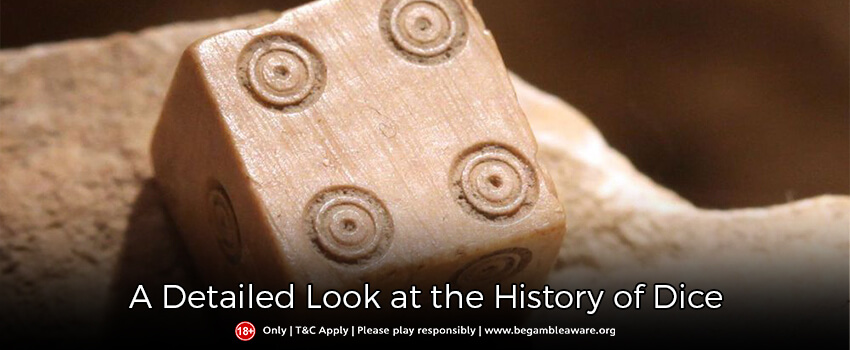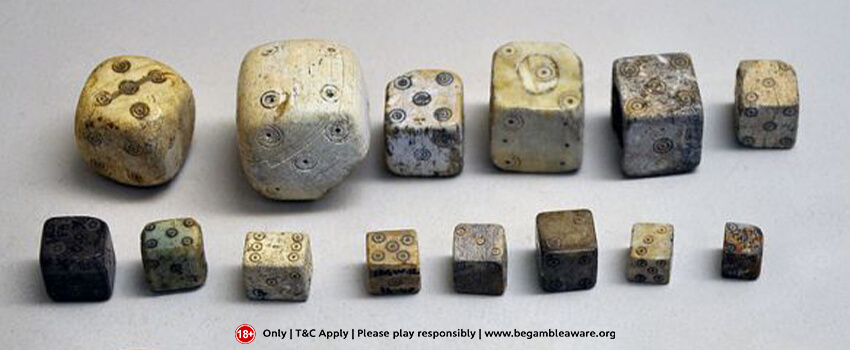Blog Posted on 07/06/2022 | Author: Karen Macarthur
A Detailed Look at the History of Dice

In this article, we will tell the history of dice with all you need to know about. It doesn’t matter if you use the plural or singular dice for this exercise. This guide will provide history of dice, fun facts and obscure knowledge of dice. Let’s roll.
Take sides
The standard cube is the most common dice we know, and each side is numbered 1 through 6. The opposite sides add up to seven, with each side numbered 1 through 6.
You might not be aware that there is a dice with 120 sides, the Disdyakis Triacontahedron. Cool? Yes. Practical? Not so practical. It’s possible to end your family’s game of Snakes & Ladders in a flash.
The dice have evolved dramatically over the years, from pentagons and prisms to spheres. Let’s go back to simpler times. Disdyakis Triacontahedron is one of the oldest dice in the history of dice.
A game for all ages History Of Dice
Although it’s difficult to pinpoint exactly when and where the dice were made when we see the history of dice, they are believed to be the oldest gaming instrument and have been around for thousands of years.
Original dice were made from the ankle bones of animals. Tusks and hooves were also used to carve them into shape, with small symbols or circles inscribed on each side. They were originally used to predict the future. Fortune tellers still use this technique to this day.
Many a year, it was believed that the dice fell because of the actions of gods and supernatural forces. This changed when Galileo and other dice experts used mathematical analysis to analyze the dice and discovered the concepts of probability and randomness.
Officially, Burnt City is where the oldest dice were found when we see the history of dice. It’s an archaeological site in south-eastern Iran. They were thought to have been used to play Senet, a similar game to backgammon. This was found to be dated between 2800 and 2500 BC. We are rolling back the years.
Since ancient times, dice have been used extensively. The Ancient Greeks played ‘Knucklebones’ while the Romans used four- or six-sided dice to gamble.

They are ubiquitous today, thanks to their modernization. Craps is one of the most popular casino games, but many other dice games are available, including klondike, which can be played with five dice, and others depending on where you live.
There are also board games. They wouldn’t be the same without dice. Monopoly is impossible without them. Yahtzee, another popular game, uses five dice to create different combinations and score points. We think the history of dice is fantastic.
Early Paintings
The early Dutch and European paintings of drunks in taverns featured them often playing dice and cards. It seems that drinking is part and parcel of this game, as shown by the large pottery jugs found on the floor of many Dutch paintings, particularly those depicting tavern scenes.
We were surprised to discover that many artists had painted dice characters. It is one of the oldest known gaming tools, but its origins are still a mystery. The history of dice as we know them has been fascinating.
Sophocles, a Greek poet, claimed that the Greeks invented dice in 400 BC. However, this claim has not been proven. We have evidence that dice were found in Egyptian tombs from 2000 BC. However, archaeological digs have allowed us to locate them further back, at 6,000 BC.
No matter the case, dice were still used by many ancient cultures. But not always as a game device. Certain rulers used dice to predict the future for centuries. Ancient people created the cube-shaped dice that we all know today. They used a variety of pieces, including seashells and nut shells. These were also used for fortune-telling.
Skilled Players
The Romans and Greeks were both considered to be skilled dice players. Roman emperors are reputedly compulsive gamers of the game. Many centuries later, in England, Richard the Lion Heart, King John, and others enjoyed playing dice.
This was especially true when it involved betting and gambling. Henry VIII, a well-known dice player, lost a bet on dice, eventually costing him his bells at St. Paul’s Church.
English inns were a popular hangout for people who wanted to play dice. Early English etchings show men with dice and chips, which shows that gambling was thriving back then.
A few artists have created paintings depicting men playing dice over the centuries. Apart from the Dutch painters who were skilled in genre scenes during the 17th century, some artists and engravers worked at earlier times, whose work documented men playing cards and dice.
Another famous artist was Caravaggio (Michelangelo de Merisi), an Italian master who painted “The Cardsharps” in oils. It was created in 1594 and is currently displayed at the Kimbell Art Museum, Fort Worth, Texas. This painting shows a group playing cards with soldiers, a very popular topic in the early 17th century, particularly in Italy.
The Dutch 17th-century painters were known for their ability to paint genres that included card-playing and good dice games. The Gamblers is a well-known 1623 painting that depicts a group of men playing dice.
Fun facts About History of Dice
Here are some useful and simple informational nuggets for you to take in.
- Latin for “something given or played”, dice derives its name from the Old French word de.
- Irish Seimetsu Co-produced the world’s smallest dice, measuring 0.3×0.3×0.3mm.
- It was auctioned for PS 13,583, the world’s most valuable dice! It was 20-sided and featured a unique symbol on each side.
- Henry VIII was a well-known dice player and lost a game that cost him his bells at St. Paul’s Church.
- The dots also have a name. Officially, they’re called “pips”.


